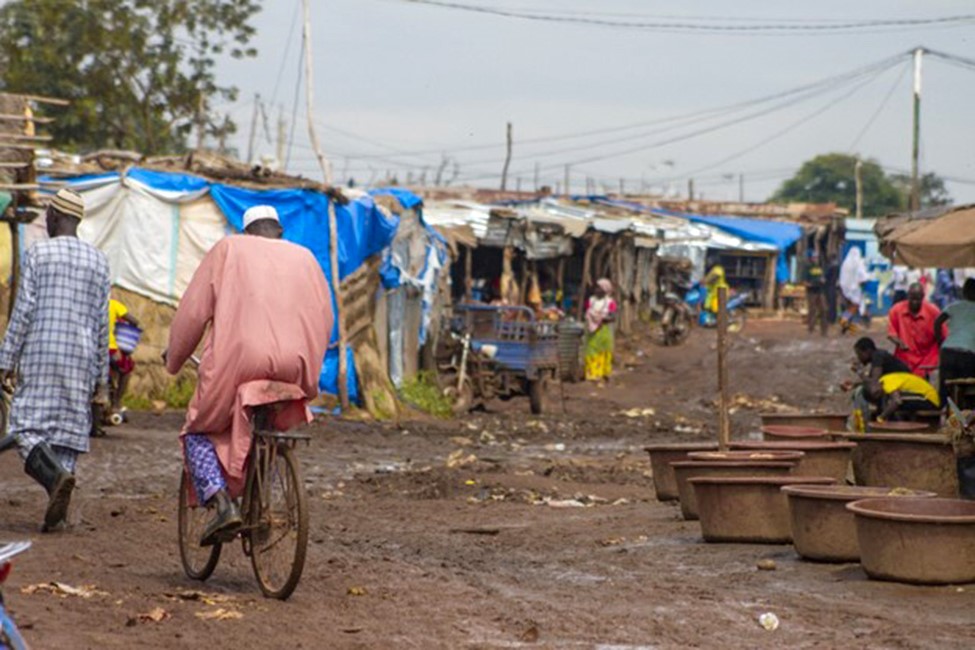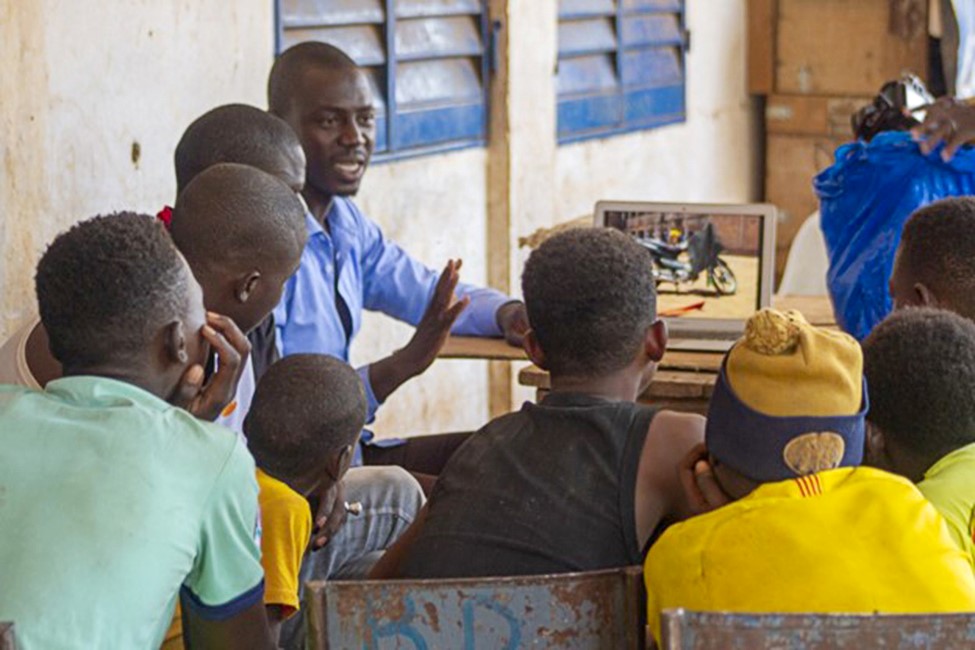Peacebuilding in Mali Through Photovoice
- Stephen L. Esquith, Ph.D.
- Professor, Department of Philosophy
- Residential College in the Arts and Humanities (RCAH)
Project Overview
- This project outlines the process of using photovoice as a method of storytelling for youth living in internally displaced persons camps in Mali, Africa.
- Through photovoice, residents in the camps help themselves and others better understand the issues they are concerned with in the camps including scarcity of resources and violence.
Products/Outcomes
- Shed light on the lack of stability and widespread devastation residents of the camps face.
- Encourage a form of active listening and open-ended discussion that may lead to more creative solutions for peacebuilding, led by the people in the camps.
Partners
- Camps for Internally Displaced Persons in Falajie, Mabilé, and Niamana, Mali
- Educational Institutions:
- University Institute for Technology (IUT) of the Université des Lettres et des Sciences Humaines de Bamako (ULSHB)
- Residential College in the Arts and Humanities (RCAH) of Michigan State University (MSU)
- Institute for Popular Education (IEP) and Ciwara School, Kati
- Malian team leaders from IEP, ISA, and RTP
- MSU faculty and RCAH students
- Non-governmental Organizations:
- Scientific Animation without Borders (SAWBO)
- International Sports Alliance
- Right to Play (RTP)
- Malian Commission for Truth Justice and Reconciliation (CVJR)
- ULSHB faculty and IUT students
- Yamarou Photo Studio, Bamako, Mali
- Yamarou Photo Studio staff
- Youth in three IDP Camps
Form(s) of Engagement
- Community-Engaged Research
- Community-Engaged Creative Activity
- Community-Engaged Teaching and Learning

Camp for internally displaced persons in Bamako, Mali 2022
More than 60 years ago, the landlocked west African country of Mali was regarded as a developing nation moving toward democracy. However, since the coup d'état in 2012, the country has faced an increasing amount of violence and is currently governed by military junta. Conflicts between differing ethnic groups as well as tensions between armed government forces and civilians, made worse by armed intervention by terrorist and mercenary groups, have left Malians displaced from their homes and seeking refuge in internally displaced persons (IDP) camps within Mali.
Unlike refugees, who cross national borders, internally displaced persons don't have the same amount of international protection, emergency assistance, or development aid. To date, there are ten official IDP camps in Mali, supporting more than 420,000 documented (and many more undocumented) individuals including three camps in and around the capitol city of Bamako in the southwestern region of the country.
Sometimes, conflict and violence between groups living in the camps mirrors the hostilities outside the camps. This, coupled with the scarcity of resources, leave persons in IDP camps pursuing solace and safety in poor and potentially dangerous living conditions.
Dr. Stephen Esquith, professor in the Residential College in Arts and Humanities (RCAH) and the Department of Philosophy at Michigan State University (MSU), is looking to help young people living in these camps tell their stories by creating conversations around peacebuilding in Mali through a technique called photovoice. Through photovoice young residents in the camps help themselves and others better understand the issues they are concerned with in the camps and also in other poor communities experiencing similar forms of violence.
Using Photovoice
Esquith's work in Mali began in the early 2000s. Over time, he became more familiar with the country, its people, and the increasing number of challenges they face, including political instability, violence, climate change, and poverty. When Dr. Weloré Tamboura, professor at the Université des Lettres et des Sciences Humaines in Bamako, Mali (ULSHB) came to MSU as a visiting professor in 2018-19 through the MSU Alliance for African Partnership initiative, they began their reciprocal collaboration on various peacebuilding projects and classes in Mali and in the Lansing area leading up to the current photovoice project.
"Peacebuilding" refers to overlapping humanitarian, development, and security measures to protect societies which may have formally signed peace accords but are struggling to avoid civil war.
"I began in 2004 with local discussions between teachers and peace education team leaders in Mali about girls' education, youth unemployment, and post traumatic stress," Esquith said. "We were interested in how these stories could prompt open-ended conversations in schools and communities where local conflicts exist."
With that strategy in mind, Esquith and Tamboura later connected after the 2012 coup d'état with the Malian Commission for Truth Justice and Reconciliation (CVJR) who had taken roughly 16,000 written depositions from victims of state and non-state violence.
Esquith said some of the stories shared by Malians with the CVJR were turned into video animations with help from MSU's Scientific Animations Without Borders (SAWBO). These animations were shared with MSU and Malian university students in 2019-20 together on Zoom to gauge their responses, compare reactions, and gather suggestions for revision and local dissemination in Mali.
"At this stage, Dr. Tamboura and I decided to explore the possibility of using the SAWBO animations that could be shared via Bluetooth and social media using personal cell phones in the IDP camps to encourage conversations there," Esquith said.
Unfortunately, progress was paused when in 2020 the COVID-19 pandemic erupted along with an increase in violence from the military, making it difficult for CVJR to host more than three sets of public hearings, and for Esquith and Tamboura to implement plans to use the video prompts for community discussions in the camps.
"At the same time as school closures were happening due to teacher intimidation, we saw the youth population begin to spike in three IDP camps near Bamako: Falajie, Mabilé, and Niamana," Esquith said. "We knew we had to rethink our strategy and come up with something that could be brought to the camps that would still promote open dialogue."
Esquith, Tamboura, and their teams of Malian students and peace activists decided to use photography as a way for youth to speak to life in IDP camps based on their own lived experience.
"Using a camera doesn't require a high level of formal education, and with the growing number of youths in the camps, it was important that we provided them the opportunity to tell their stories," Tamboura said.
University and Community Join Trust Building Efforts
With young people in the camps, ages 13-22, as the preferred storytellers, and photovoice as the preferred method to tell the stories, Tamboura recalls approaching camp coordinators and social workers, describing the project and its goals.
"Our first interactions revolved around open, honest communication and developing a sense of trust," Tamboura said. "We explained our project, outlining our desire to give youth a chance to communicate through photographs, and even brought an official letter from my university to show we were genuine in our request."
After being given the approval to proceed, Tamboura says the young students were initially very timid and shy, often questioning why people were interested in their living conditions.
From these early exchanges it was clear that a level of personal rapport would be necessary to make the youth feel comfortable in order to successfully move forward with photographing daily life in the camps.
University students from the Institut Universitaire de Technologie (IUT) within ULSHB, ages 19-25, volunteered to serve as mentors for youth in the IDP camps and were a crucial piece in gaining the students' trust while also bridging the gap between university and community.

Photovoice instruction led by Yamarou Studio for youth in internally displaced persons camp in Bamako, Mali, 2022
Local organizations in Bamako also rose to the occasion, offering their expertise in a variety of areas. Moussadjie Dembele with the Institute for Popular Education (IPE) and Boubacar Sy with the International Sports Alliance (ISA) each have experience when it comes to peace education and trust building with youth. Through activities like games and drawings, Dembele, Sy, and their colleagues, were able to encourage young people to develop conversational skills and explore their feelings around conflicts within the camps.
"During the workshops, we were able to teach youth how to have more patience, control their emotions, and take care of each other," Sy said.
As the weeks went on, the teams noticed a considerable change in demeanor as the youth in the camps began opening-up during discussions and often spent their time reflecting on past traumas, barriers they've faced, and future fears.
"Many youth in Mali, especially those living in the camps, have never had access to this sort of collaboration, so seeing them become more comfortable with us brought a lot of joy to everyone," Sy said. "After one of our sessions, a student even said to me, 'I feel like I can fly.'"
Introduction of Cameras
Once strong relationships between students and mentors had been established, Esquith, Tamboura, their Malian team leaders, and Tamboura's Malian university students introduced cameras and formal photovoice instruction to the youth with guidance from the Yamarou Photography Studio in Bamako. The studio provided the ideal partnership as they actively worked to create a space for dialogue between young people around photography, while also offering both training and reflection sessions for photography professionals with the public.
"Not only did staff at the studio teach the students basic camera and visual literacy skills, but also how to take a quality picture and capture the story they were trying to tell," Dembele said.
The photographs taken by students shed light on the lack of stability and widespread devastation residents of the camps face. Many of the photographs showed the temporary shelters individuals lived in and assembled using plastics bags, tarps, and pieces of canvas and blankets. Backdrops of other photos showed scattered trash and waste as the camps lay on landfills.
While these challenges need to be addressed, Esquith says the goal of using photovoice was not to provide answers to problems people are experiencing in the camps, but rather provide a space where individuals can explore different sides of complicated questions so they can address the problems collectively.
"We aren't in the business of didactically handing out solutions, but rather finding a way to encourage a form of active listening and open-ended discussion that may lead to more creative solutions on the ground, led by the people in the camps," Esquith said.
Exhibitions Showcasing Photos
As the photovoice project has been underway for nearly two years, the next steps involve exhibiting the photos that have been taken. Photos will initially be exhibited in the Yamarou Studio to allow both mentors and mentees to learn how to present their stories and respond to questions from the public.
From there the exhibit will travel to ULSHB, and other IDP camps to start a dialogue between community members around peacebuilding.
Depending on the success of the photovoice project, Esquith says they have plans to create a storybook using photovoice images as well as develop a website dedicated to the project.
Additionally, they plan to collaborate with students in the U.S., South Africa, Colombia, Benin, and Senegal where other instructors are doing similar work.
Resiliency of Malian Citizens
"This project has been very encouraging," Esquith remarked. "Malians are resilient, and I'm appreciative of the chance to see how people navigate such difficult circumstances while maintaining dignity and the willingness to struggle for a better life."
Tamboura added, "Finding simple joys while living in the IDP camps can be difficult, but seeing the youth get excited to be a part of this project and take pictures has been truly inspiring. We are able to give a voice to those who are usually voiceless."
- Written by Emily Springer, University Outreach and Engagement
- Photographs courtesy of Stephen L. Esquith